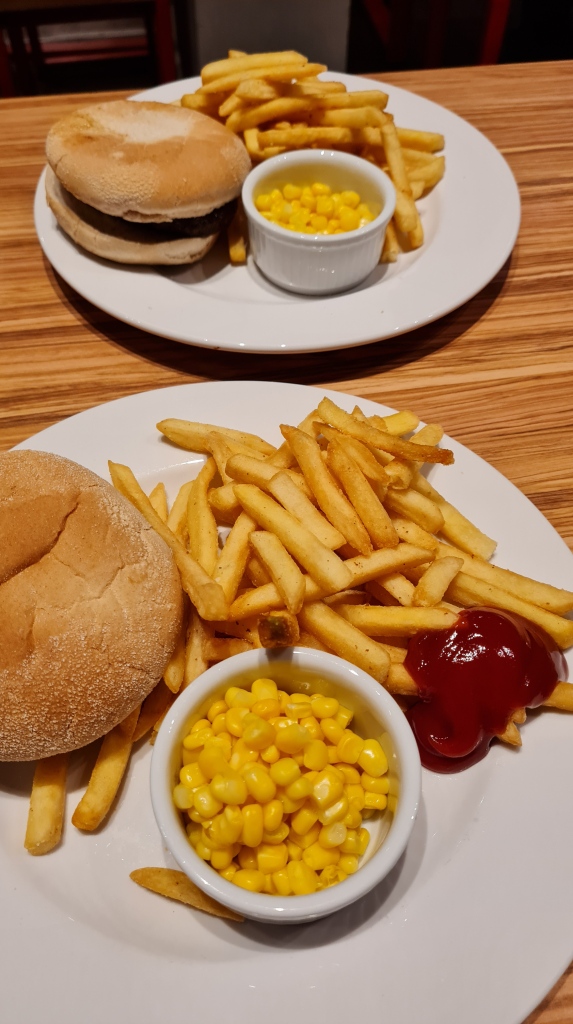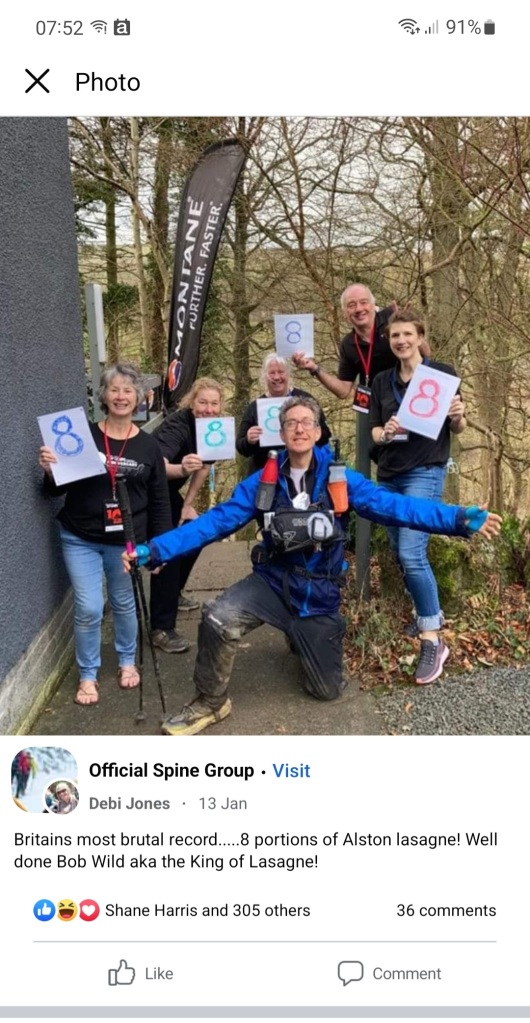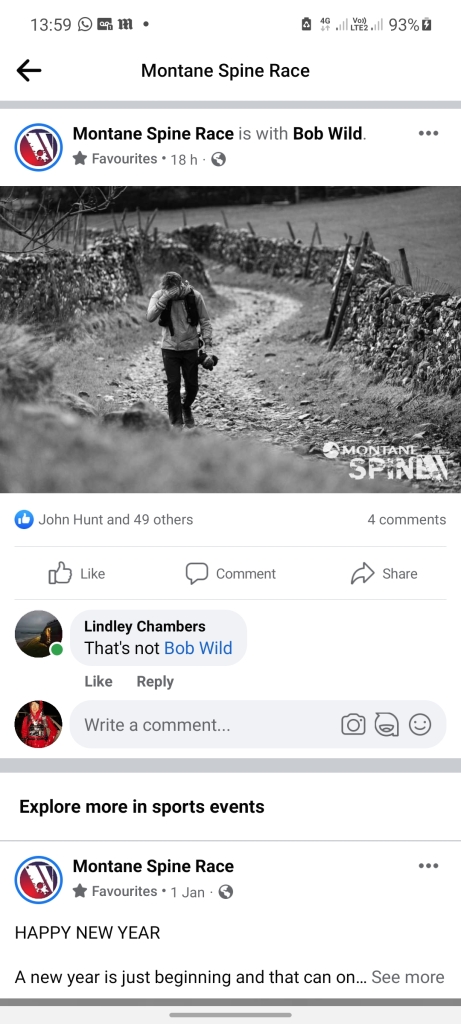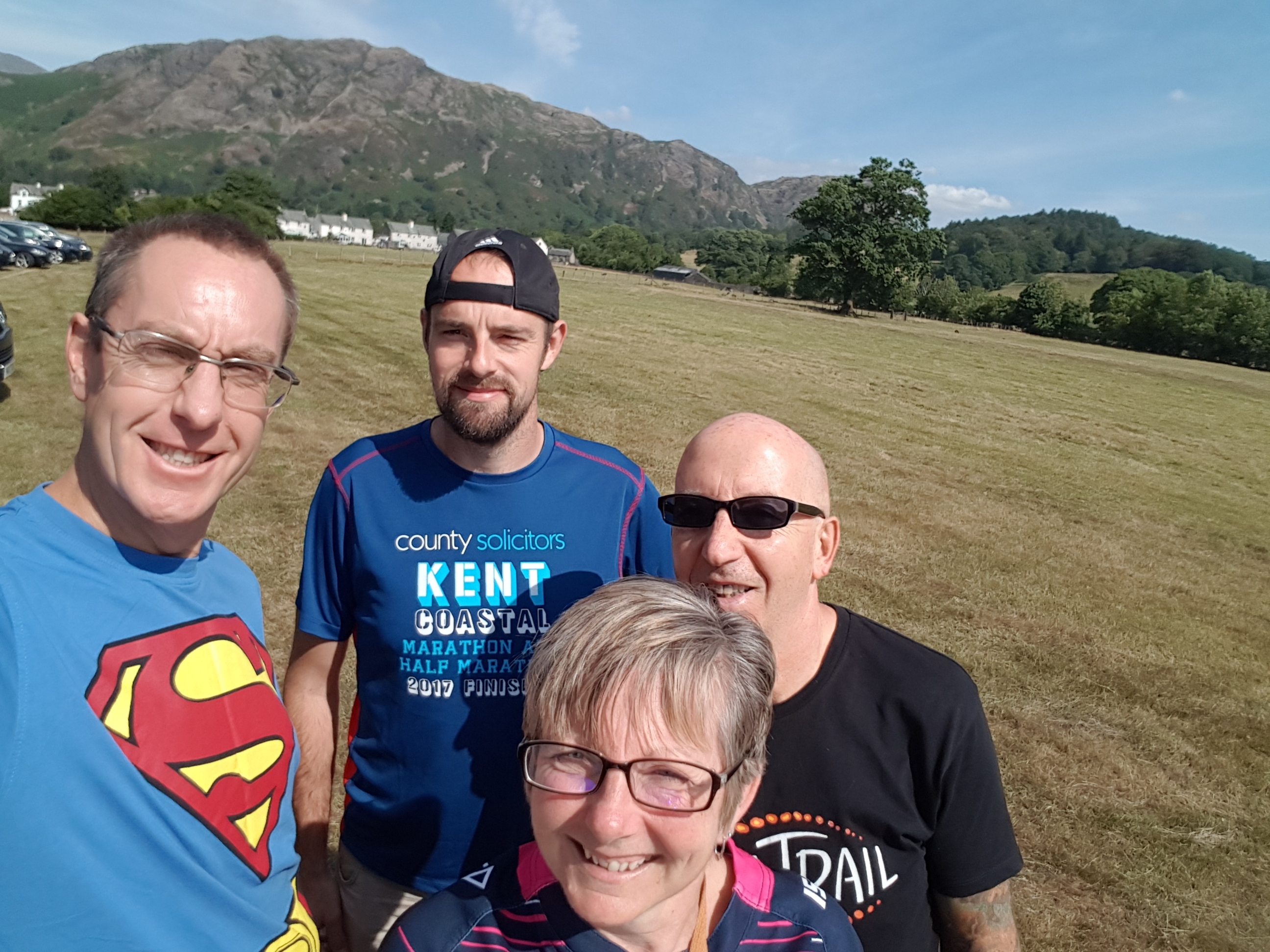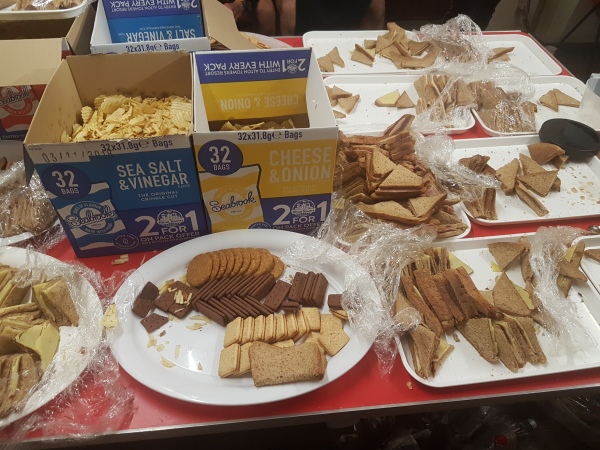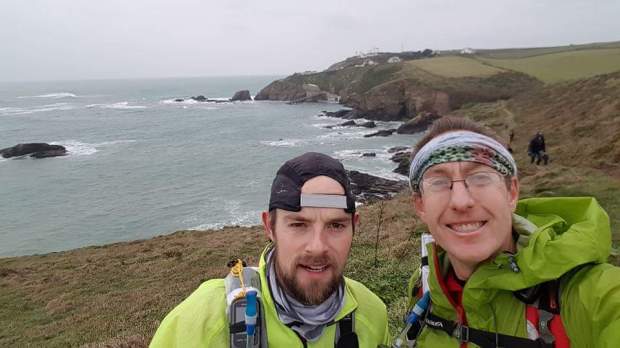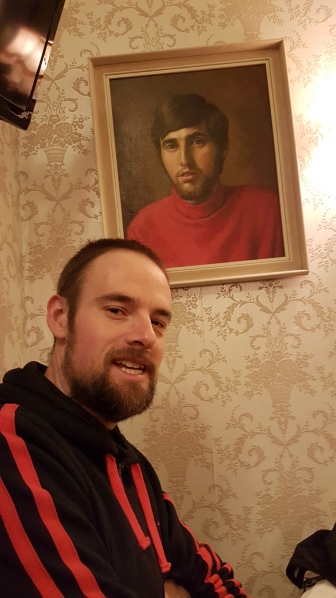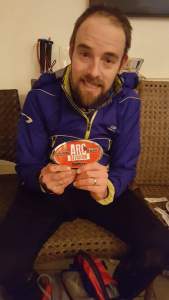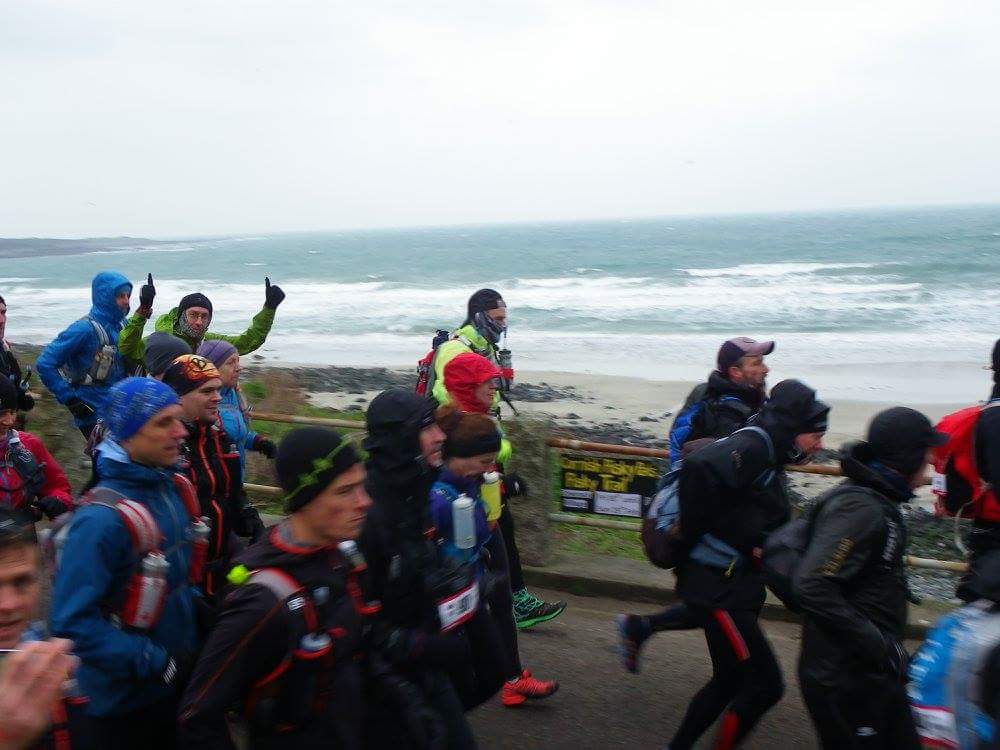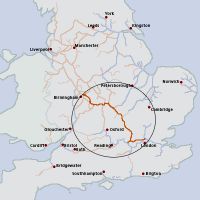The Spine race is the hardest ultra in the UK. There, I said it.
It bills itself as “Britain’s Most Brutal…” and although there are some that would disagree, I’m not one of them.
The race covers 268 miles of the entire Pennine Way, from Edale to Kirk Yetholm across the Scottish border, with 13135 metres of climbing (Everest is 8848 metres), terrain that varies from bog to occasional flagstone paths and then back to bog again, in some of the most isolated places in Britain. It takes place in January so you get the “full intensity and ferocity of the British winter” according to the website.
Due to the isolated nature of the race you are required to carry a significant amount of kit such as sleeping bag, sleep mat & bivvy bag to sleep outside if necessary, cooking system and dehydrated meals, spare clothes and more gloves than you can wear at one time. I could go on, but you’ll begin to glaze over with kit fatigue. Unless of course you’ve done the race or are planning to, in which case you’ll talk for days and weeks about the relative merits of lithium versus alkaline batteries (lithium last longer in sustained cold) and weights of numerous types of expensive sleeping bags. Usually the pack you end up carrying will be about 6-7.5kg, depending on how much you’ve spent on getting the lightest possible kit, and then add in a couple of litres of water and some emergency chocolate biscuits and you are carrying up to 9-10kgs for a week.
There are 5 indoor checkpoints, allowing access to a drop-bag, medics and some light and heat for eating and sleeping, but the clock keeps ticking throughout so they are not places to linger!
The darkness in January descends at about 4.30pm, and is all encompassing until perhaps 8am, so easily 15 hours of darkness each day. And let’s be clear, this is ‘proper’ dark, with no streetlamps to guide you or houses to illuminate the surroundings. You are in a small pool of light from a head torch, allowing you to see a couple of metres in front of you…but that’s it. There could be a steep drop a few feet to your left and you would never know until you stumble in that direction.
And did I mention the weather? It’s cold, windy, wet underfoot, and hopefully the rain will stop every few days to give way to snow or sleet. The route is beautiful but exposed, and there is little or no chance of shelter if the wind gets too much. Generally the climbs take you to a different weather system, so at the bottom of a big climb you are in damp cold conditions, but after 30 minutes of hard leg-sapping climbing it’s blowing a gale in thick fog, with the temperature an easy 10 degrees colder than before. The changeability of the weather is a constant challenge – it’s quite easy to get too warm on a climb, fill your jacket with sweat and heat, and then freeze when you unzip at the top to let the heat out.
If you know about the Spine, then you already know all this. If you’ve never heard of it, take a look at this 56 second video ‘teaser’ that has been released by a media company that do some awesome videos during the race itself.
What that video cannot portray is the human stories which develop each year, usually at the back of the field, where ‘ordinary’ people like me struggle against incredible adversity to complete the race within the cut-offs. Over the last few years, when I along with many others have been following the race trackers, people have dnf’d (did-not-finish) a mere 5 miles from the end, or have been prevented from continuing due to impossible weather at the final checkpoint, or have missed the final cut-off by simply going too slow for the final 40 miles over the Cheviots.
Alternatively, ‘ordinary’ people have achieved the finish against incredible odds, when they rightly should have collapsed with exhaustion and lack of sleep days previously, they have somehow dug deeply within themselves to carry on, proving once again the indomitable spirit that each of us is capable of.
As you can maybe tell, the Spine race brings out something special in people, driving them to heights that their normal humdrum existence does not give. It elevates them to achieve results and emotions that are perhaps the most elusive, difficult to reach, but the most memorable.
It was on this basis that when I became aware of the race in about 2015, I decided I could never do anything like that.
A little about me and my running life? OK. London Marathon in 2008, followed by more marathons, all quite slow.
Got bored of marathons and took up Ironman triathlons in 2012 & 13 (having believed in 2010 that I could never do anything like that).
Got bored of Ironman after a couple of years (far too much training for only 13 hours of racing) and discover ultra running…and got an entry into the Grand Union Canal Race, an iconic 145 mile race from Birmingham to London in 2014. Lots of training for an epic 32 hours of suffering…this was great!
A few years later I was a happy slow ultra-runner, having a great time at the back of the field treating each race as a holiday. The Arc of Attrition in early 2017 was a 110 miles round the south west coastal path, but training for it through winter with my good running buddy John made it seem bearable. The Thames Ring 250 in mid-2017 was a great time and at 80 hours for 250 miles showed I was a poor runner but a great hiker! In fact my race style was becoming defined as a bit of running at the start and then lots of walking, quickly. And it worked, I was less sore and stiff after 100 miles of walking, and only slightly slower than the runners.
In 2018 I screwed up my courage and attempted the Spine Challenger, a shorter version of the full Spine that this race report is all about. It was a good opportunity to see how I found the dark & cold, not to mention the terrain and carrying a heavy pack. I enjoyed the race and found myself less bothered by the biblical weather that I experienced for the last 8 hours or so of the 43 hours that I took.
All this time I had been watching a certain race called the Monarchs Way, a monster 615 mile race put on by Lindley Chambers of Challenge Running. This race was simply lethal, and in about 5 years of being run had no finishers until 2018 despite having some superb racers. With a bit of confidence from the Challenger finish, I entered and completed the Monarchs Way in May 2019, although I took some damage to mind & body along the way. It was a long hard race, and my feet simply fell to pieces from about halfway.
I should quickly point out here, my success in these races is not down to athletic ability. I have no athletic ability. I spend the vast amount of these races walking/hiking albeit quite rapidly. My success, in my opinion, in down to a certain stubbornness, an unwillingness to stop or give up. I have an inclination towards finishing what I start, despite setbacks, and as my good friend John told me, I know how to suffer. And keep suffering, and keep moving throughout it. It may not be pretty, but it usually gets me to the end.

————————————–
Well done reader, you’ve made it over the slow start and backstory! I can now offer you a choice…either read on through a brief summary of the 18 months run up to the Spine race 2022, or follow the link to a tale of Lockdown, hamstring injuries and cancelled races (May 2019 – July 2021)
Summary of May 2019 – July 2021….finished Monarchs Way, tore left hamstring & stopped running. Global pandemic. Got fat and lazy. Enjoyed being fat and lazy.
————————————–
Time jump! Its July 2021, we are mid-pandemic. Winter Spine 2021 was cancelled, but it looks like it may go ahead in 2022. Better do some kind of training if I’ve any hope of getting to the start line. Follow this link to PRE-SPINE July 2021 to Jan 2022 if you want to understand what sort of training I did, despite a dodgy hamstring preventing any purposeful running (my favourite thing). Without running, I was going to have to ‘train’ in a meaningful way rather than just ‘go running’ when I felt like it.
TL,DR for July 2021 to Jan 2022 – lots of climbing the cliffs Folkestone, especially overnight, and lots of climbing on a stupid stepping machine at a local gym. And lots of hiking with a heavy pack. Lots of training basically.

Time jump! It’s January 2022. Despite my best hopes, it does not look like the Omicron variant of Covid is going to cause a lockdown that will cancel the Spine 2022, and that means I may have to do it after all. I’m not exaggerating when I say that just thinking about what was ahead of me caused my heart rate to increase and to feel my chest tightening and breath quickening. I had a severe case of race-terrors, all entirely justified, and my usual nervousness was developing to raging anxiety and fear.
My long-suffering wife knew what was up, and running friends, Mark & Sharon, came round for a post-Xmas Christmas dinner, to wish me well & commiserate with what I was about to do to myself, but looking back it all seems like a bit of a blur, that I was not really in the room as I was focused elsewhere.
On the day before I was due to travel to Edale, Facebook suddenly filled with pictures of snow, ice and skidding cars that could not get to registration for the shorter Spine races that set off a day earlier than the full Spine. At work, out of my window in sunny Kent, it was blue sky, 10 degrees, and bore no relation to what the north was experiencing.
Before I knew it, I was on the train to Edale, listening to classical music to try to calm my nerves and clear my head. I got a taxi from Sheffield with two other racers, Richard and Mark, and whipped through registration and full kit check in record time. (Full it check? No problem! Like most people I knew the mandatory kit list like my own address and sailed through it).
Beef burgers at the YHA in Edale were a last hearty meal, chatting to an ex-commando who used to spend winters in Norway with the army, living in a snow-hole. As usual, I’m feeling some strong imposter-syndrome here, and get myself off to bed as soon as I can, looking the poor weather forecast as I go. Facebook pictures of the racers that set off the previous day show horrible icy conditions underfoot and a fair bit of rain and snow. Not encouraging.

Having sorted my kit for the umpteenth time, I get a half-decent sleep, being woken up a few times by impressively loud rain on the window to my room. Excellent.
Sunday morning, 5am. Shower, breakfast, kit faff, give in my drop bag. I’m standing in the YHA reception waiting for a minibus to take us to the race start, with a few other racers and the eventual winner Eoin Keith. He’s a proper gent, chatting away to the others about waterproof jackets and kit while I skulk in the corner keeping my imposter-syndrome company.
Mini-bus to the start, tracker fitted to my race pack (useful for locating my dead cold body) and then we are moving to the race start.
It’s actually happening, I’m about to start the Spine race, a race I’ve been terrified of for years, a race that I’ve never really considered I was qualified to start. I chatted to a lovely guy call Paul Dunn on the walk to the start and we took pictures of each other under the start gantry. I suspect that most people will not understand the significance of that picture, but there is not many people that stand under the gantry about to start the hardest race of their lives.
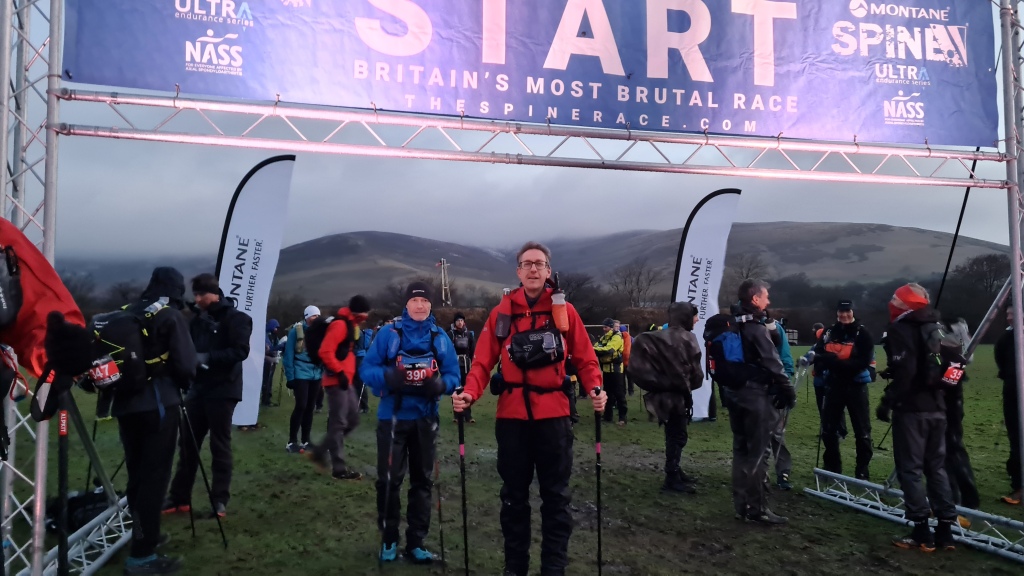
And we started.
————————————–
Congratulations! You, dear reader, have made it to the start of the race. You deserve a cup of tea and a stretch. Well done.
————————————–
It is 5 minutes in, we are crossing the fields on the first mile of the Pennine Way, it starts to snow and the wind make is horizontal and blow into our faces. Excellent. This was a taste of things to come, but it was what we were here for.
The first proper climb is Jacobs Ladder, a mere 183 metres (600 feet) but it’s the first of many and will get us high enough to change the weather for the worst and give us all our first taste of proper Spine weather. Sure enough, it is noticeably colder at the top, and the mist is restricting visibility to just 5-6 metres. I could see vague figures in the distance moving slowly over the icy rocky path, using their poles to stay on their feet, and found I was doing the same. It wouldn’t be good to slip and twist an ankle so soon.
I began trying to keep up with the figures in the distance, not because I needed them for navigation (I’m quite confident using my GPS unit) but more for the reassurance that there were other people out there. Even that early in the race, it felt like another world away from cars, shops, light and heat.
I gave up trying to move at other peoples’ pace, the ground was too slippery and icy. Wherever the icy rocks stopped it became boggy and muddy so did not seem worth it to move at a pace I was not comfortable with. I drew level with a guy call Luke who I would end up spending most of the day & night with as we had both decided that speed was better sacrificed for safety. Luke was great company, and we chatted the morning away swapping stories of home life and what brought us to the Spine. We reached the first small aid station at Torside, and I had a coffee, surprised to see other having a full sit down and dehydrated meal.
I left the aid station shortly before Luke, expecting him to catch me up quickly, but it seemed to take ages and I was worried he’d think I was trying to avoid him. Luckily, he’d spent a bit more time kit-faffing than I’d realised, and he soon was back with me, and we were soon joined by Graham as it got dark. Although it was only the first night, we all seemed to take comfort in travelling together as the light and company kept the monsters away.
The terrain varied from grassy bog to flagstone paths. A lot of the paving slabs were slightly icy, but the real traps were the ones with a puddle of water covering a layer of ice, which you would happily step into only for your leg to shoot out the other side when there was no grip. I took to following the path but remaining on the boggy grassy verge to avoid the inevitable ice.
That first night was the most conversation I had all race, and we learned that we were all about 50 (after I joked that I was the old man of the trio) and that Luke was the legend that had run to the top of Pen-y-Fan in a string vest and posted about it on Facebook – legend!

The weather through the night was cold but not horrendous. Snow falling on the tops of climbs turned to rain or drizzle on the lower stages, but my kit was holding up well and I was quite comfortable. I’d opted to start in waterproof trousers which, although bulky, meant I stayed warm and dry whatever the weather threw at us and also meant I did not get wet when I inevitably fell over in the mud and wet.
The three of us got into Hebden Hay at about 00.30am (74km, 46 miles, 16 hrs 31 mins), with Grahams wife waiting patiently at the roadside for him (She’s a keeper Graham, I didn’t see anyone else’s wife there!). Hebden Hay was well organised, with a corner marked out for getting rid of muddy boots and sorting kit. I was well-disciplined, sorting myself out (new batteries into GPS, all rechargeable bits plugged in to charge, feet checked and cleaned etc) before eating a little and getting some sleep. I had originally intended to have just an hours sleep before moving on, but Luke suggested an extra hour would not mean much in a weeks’ worth of racing and I took his good advice. I felt much more awake after a decent sleep of a couple of hours, although a bunk room with 6 other snoring racers was not an ideal environment.
I ate a little more, just feeling a touch of nausea, and then put on some lovely clean liner socks under my waterproof socks and the same heavily waterlogged shoes which went back on easily enough and the rest of my kit slid back on as if it had never been away. The next stage was going to be a tough one, 61 miles and over 3000 meters of climbing, including the serious climb of Pen-y-Ghent. I’d done this section during the Challenger race in 2018 and although I had finished it I did not have happy memories of it.
I left the checkpoint at about 4am, about 4 hours inside the cut-off, and linked up with a Portuguese racer in the dark who told me about his struggles to get to the start line due to Covid restrictions. As it got light I was moving well and was looking forward to Gargrave, a town that I would likely hit during opening hours so I could get some food from a cafe or shop (the legendary Co-op). I was not eating much by this time, as usual my stomach was gently protesting about what I was putting it through by resisting all attempts to get solid food into it, but I was confident that, like on Monarchs Way, once I stopped and rested, I would be able to eat enough to keep me going for another 12 hours.
There was nothing of note in the next few hours except I felt good. I was making good time and moving easily over the rough terrain. The weather was reasonably forgiving, cold but not raining, in fact the only water was underfoot as the ground was extremely wet and boggy in places. I came across a couple of hikers going the opposite direction, hesitating on the far side of a stream before crossing it. While I call it a stream, it was probably nearing river status as the usual stepping stones were submerged under a few inches of water and the water was flowing quickly over and past them. Clearly the run-off from the previous few days rain and snow was reaching lower ground and swelling the usually tame streams.
The elder of the two hikers started first, and the water was just short of his knees as he strode quickly across. He avoided the stepping stones as they looked slippery and just put his feet where he hoped was good footing using his poles for steadying him against the flowing water. His companion was hesitating so I took the opportunity to get across, following the path the hiker had already taken. The water was surprisingly cold on my shins, but I thought that if I moved quickly enough I would lessen the time the water had to get through my waterproof trousers, gaiters, walking trousers, running tights, Gore-Tex boots, knee length waterproof socks, and finally my liner socks, and feet covered in a thin film of Vaseline. As you can see I was prepared with anything to keep my feet as dry as possible. This would be the first of a number of stream/river crossings in this area. The widest took 8 big strides to get across, the shortest only 4, and I’m thankful that I stayed on my feet through them all. By the end I could not tell if my feet were wet or not, and did not allow myself to dwell on the possibility of hiking in wet shoes and socks for the next 40 miles. In the end I think my multiple layers of protection did the job and my feet seemed to cope with the crossings, although by the end of this leg the permanent boggy ground would begin the gentle deterioration of my feet.
Gargrave came but all I could see was lots of racers having a rest and eating dehydrated food in a central bus-stop and even more heading off to the Co-op. By this time, with no solid food since the leaving the last check-point, I wanted proper food! I backtracked to a pub I’d passed, the Mason Arms, and proceeded to get their floor muddy while I drank 4 pints of milk and had the best part of 2 large lasagnes. The landlord was gently bemused at my slightly odd behaviour, but was happy to feed me. Another runner came in while I was eating, and proceeded to DNF in front of me despite me using all my (disappointingly) persuasive arguments for why she should carry on to the next checkpoint. It was quite maddening actually, as she was clearly in a good place physically, but had mentally checked out of the race and I knew she’d regret the DNF at a later stage. I didn’t get her name, but I vowed to myself when I left her that I would not let that happen to me, I would not stop until I physically (or medically) could not carry on.
I stayed much longer at the pub than I planned, and Gargarve was deserted when I left, having been full of runners when I went into the pub 90 minutes earlier. Whoops. However, my unreasonable stomach had been quietened with lasagne and I was on full-speed hiking to catch everyone up! Unfortunately the path to Malham Cove had had a few hundred runners on it for the last couple of days so was particularly muddy and slippery. It was getting dark on the road through Malham, and fog descended leaving poor visibility as my head torch bounced light off the million or so droplets of water suspended in the air.
I powered my way up the steep steps alongside Malham Cove, not realising just how disoriented I would be at the top in the dense fog and dark.

I’m told there is a route that does not involve balancing on the edges of slippery rocks and risking a broken ankle by slipping into a gap, but I could not find it. Subsequently, I was making my own way on the shortest route along the slippery rocks to get to the far side, simultaneously swearing at myself at how f*cking stupid this was and how much I was risking if I took a wrong step. After a fairly sweary 15 minutes, I reached relative safety, and told myself that I really should have waited for some people that knew the correct route across the limestone. I’ve been over the top of Malham cove twice now, once in daylight (during Challenger in 2018) and once at night…but I’ve never found the fabled ‘safe’ route that avoids the nightmare balancing on top of pointy slabs.
Clearly I was taking a genuine race-ending risk by doing these slightly more difficult sections alone, and it was with this in mind that I made my way to Malham Tarn aid station, a brief 30 minute stop for food and rest before setting off for the climb to Pen-y-Ghent. I was in a bit of a state when I got in, far more worried about finding someone to go over Pen-y-Ghent with than eating (which was a mistake). Everyone else was resting with their shoes off and eating a dehydrated meal, and I was going around the room looking for someone that I would judge knew what they were doing over the climb. I’d found the relatively easy Malham Cove to be challenging, but Pen-y-Ghent was a whole more difficult animal. I was lucky enough to find a group of 3 that were leaving shortly, and agreed I could tag along with them. I was more relieved than I could say, despite the fact that I had not eaten or really rested I was happy enough to feel I had some company over the climb. I should probably defend myself at this stage, I was not being a complete wimp, but had gone over Pen-y-Ghent alone in the dark during the Challenger in 2018, in strong winds shortly before a diversion was put in place. I took risks there that with hindsight was just plain stupid and didn’t fancy repeating them in the current freezing fog.
The group of 3 introduced themselves (Richard, David & a bearded-man-with-no-name (BMWNN), and we set off over Fountains Fell and towards Pen-y-Ghent, with the mention of a possible diversion dancing in our ears from the volunteers at Malham Tarn. A diversion would remove the final difficult climb of Pen-y-Ghent and even better shorten the leg by 3 miles…bargain!
Fountain Fell was a long climb and the fog made visibility poor. The higher we got, the denser the fog until it felt like drizzle on us keeping everything wet. The others in the group, who had been up Pen-y-Ghent “more than 10 times” were clearly hoping for a diversion as even they were saying how they didn’t want to go over the climb in this weather. At the far side of Fountains Fell we could see a car parked on a road, which would be a most likely be a mountain rescue guy telling us to take an alternative route, but the disappointment was crushing when it turned out to be someone waiting for another racer to wish them luck. We were gutted.
We followed a road for another mile before coming across another vehicle, thankfully with a guy in high-viz and possibly the world’s toughest dog standing next to him in the wind and rain, to inform us of a diversion further on that would take us past Pen-y-Ghent. I won’t lie, the relief was massive as was the happiness at missing out 3 miles of the route. Happy days.
What we didn’t realise however, was that the diversion took us down one of the slipperiest rockiest hillside I’ve even descended, which was thoroughly unpleasant in the dark. The mud was too slippery to stay on, but the rocks were wet and even more slippery, and hurt a lot more when hit at speed. It was a rubbish descent. I was extremely pleased to be with people that knew the way, as apart from a hastily erected sign pointing us the way at the start of the diversion, we were expected to find the rest of the way ourselves….I’m not sure I’d have made it on my own without turning around thinking I’d gone the wrong way. However, Richard and David got us all to Horton in one slightly soggy and bedraggled piece.
It was the middle of the night, perhaps about midnight, and we were all looking forward to a small aid station at Horton, positioned at the end of the Pen-y-Ghent section as a replacement for the now-closed Horton cafe. Unfortunately, rather than an oasis of warmth to sit and recover in, we were made to stand outside under a porch (no! Can’t let you indoors, you buggers) while the volunteers stayed warm in the lobby. Do I sound bitter and pissed off? That’s because I was, we all were. I tried to eat, while the other guys sorted themselves out, but I ended up spitting everything out into the grass verge to prevent me vomiting my stomach contents everywhere. I refilled my flask with hot tea, and gave myself a mental shake…although there were still hours left to go, I was warm enough, dry enough and not out of the game yet. I had not eaten for probably 12 hours, but still had some life left in me!
I’ve read another race report that called it Horton Hell, and I can see why. Although you feel like you’ve accomplished something by getting that far there is still a hell of a long way to go! And most of it is on the Cam Road, a long depressing climb.
We left Horton and were quickly back on the route. Richard and David hung back a little while they sorted out their kit, and bearded-man-with-no-name (BMWNN) and I steamed up the start of Cam Road. At the start we passed a short guy going the other way that mumbled something about not finding the route but we were confident in our navigation and turned him round to follow us. I had a good chat with BMWNN, but never actually asked his name for some reason in all the time we were together….bizarre. After 20 minutes of strong climbing my phone started to go off, and after three missed calls I thought I’d better see who was trying to get hold of me.
Just to explain this, I usually take calls from friends and my wife during events, but for various reasons had not actually answered any calls so far in the last couple of days. Some of this was because I was with other people (Luke and Graham the previous night) and the group I had been with since Malham Tarn, but also I was really very focussed on the job in hand….surviving the Spine and not making any silly errors in my navigation or kit. While this may sound like I was taking things quite seriously, I was! I was “in the zone” and really concentrating quite hard on everything going on.
So, after three missed calls I pulled my phone out, and returned a call to the unknown number. Only to find it was race HQ telling us that we were heading up the down-route from Pen-Y-Ghent which we had been diverted away from. What a cock up! A minimum of 20 minutes of hard climbing, which then meant 20 minutes of descending, passing the short fella and telling him he’d been right and we were going the wrong way (sorry Mike!), passing Richard and David and telling them we were going the wrong way. What a bloody cock up. Whilst it wasn’t entirely my fault, I was definitely at the front and felt terrible, but everyone was quite understanding and [philosophical about it. Unfortunately, this unnecessary climb wiped out most of the 3 miles saving we’d gained from the diversion so I was quite dispirited after this.
We went back through Horton and got onto the correct route this time (cue lots of checking and double-checking) and BMWNN and I went ahead again, this time up the correct Cam Road. I don’t even want to recall how long this took, but it felt like hours upon hours of relentless climbing on a long reasonably straight track. BMWNN started to go ahead as the sleep monsters told hold of me and my energy dwindled. It had been well over 12 hours since I’d eaten anything solid, and while I was drinking loads of water to keep hydrated my body was starting to feel a bit weak and slow. I was keeping a boiled sweet in my mouth at all times to keep some sugar going through my system, but this was a poor replacement of something real to digest.
I was getting more tired, beginning to hallucinate a little, just enough to enjoy it. Suddenly I wasn’t on a track, but there were houses along both sides, they were the old style houses from Muppet Christmas Carol with old front doors and wooden beams….very picturesque. Up ahead I could see meteors falling from the sky…no, that was a lost racer coming towards me from a hill. I was just starting to lose my mind, in a very conscious way. I’d had about 2 hours sleep in the last 44: it was 3am on Tuesday and I’d begun racing at 8am Sunday. I was in a bit of trouble as I’d lost all the other racers (I didn’t know where they’d gone, probably up ahead but I couldn’t see them ahead). I knew I was on the correct route, but started second guessing myself. At one point I seriously considered stopping for a sleep if I could find any shelter, but I knew that I would get very cold very quickly unless I unpacked my sleeping bag and that would take too long. Waking up after a 10 minute sleep sounded great until you’re too cold to think properly. So I carried on, at my lowest ebb so far in the race. I was slipping and sliding all over the sodding muddy track and I remember trying to climb a grassy bank that was so steep I kept losing my footing and sliding down. Someone, possibly BWMNN, kept looking back at me and I could see their head torch lighting the bank ahead of me. Or maybe that was totally my imagination.
I got to the top of the bank, came to a gate, and was really struggling to see the way forward. It was one of those times my brain just wasn’t making sense of what was going on around me. I had over 50 miles of this leg done by this stage, but the lack of sleep was really biting hard.
And then I had a stroke of luck. I was caught by a group of three that were moving fast and went past me like a steam train. I had one realistic chance of salvaging the final part of this leg and that was to hang onto this group for dear life to get me to the next checkpoint. So that’s what I did. It wasn’t pretty, I was falling over constantly in the mud on the long descent to Hawes. One memorable occasion I somehow ended up on my back, my pack deep in the mud, with my head pointed downhill…no idea how that happened. I was hugely lucky that these guys came along when they did, and I told one of them that as we walked the last mile in the town to the checkpoint at about 5am.
Hawes checkpoint reached approx. Tue 5am, 110 miles done in 44 hours. Checkpoint left at approx. 11am
In the bright lights and warmth of the checkpoint I came back to life quickly, and wanted to make the best of my time, so I treated myself to a shower to wash off the horrors of the night and went straight to sleep. I did not eat or sort any kit, both things that I told myself I should absolutely do before the luxury of sleep, but I was in such a state that just needed to get my head down. 2 hours sleep later and I was back in the game!
Back with my drop bag, I started sorting my kit with one hand while eating as much as possible with the other. I had an excellent medic called Sam tape up a few bits of my feet that were just beginning to suffer from the constant waterlogged terrain, especially my little toes.
I was really chuffed to be told that the next leg was only 33 miles, rather than the 38 I had thought. Those 5 miles made a huge difference mentally! I practically skipped out of there (well, hobbled) on my way to Middleton. And even better, I was going to visit the Tan Hill pub, the highest pub in the UK. It was one iconic place I had not been to on my various recces and I had heard so much about it, it was going to be a treat.
It was lovely daylight and while it took a few miles for my feet to loosen up and stop hurting, but once they did I was enjoying myself again. There was a long climb up Great Shunner Fell, only to be met at the top by a particularly demanding Jo Winspear who took my picture while berating me for keeping her waiting in the cold…good work Jo! It was lovely to see a friendly face, and to be fair it was a decent day to spend on the hills. The sky was reasonably clear and although it was cold, was certainly not Spine weather! To be fair the rest of the week, after the first two days, stayed very cold but quite clear with minimal rain which was really lucky.

However, my stomach decided to play its games, and was refusing anything solid again. I hoped that Tan Hill pub would allow me to get a good feed in, as I was really feeling the lack of solid food, but I made the best of the day and moved quickly across the route.
I passed the edge of a village or town called Keld, with a tempting sign saying that a certain Keld cafe was open 24 hours for Spine racers. With hindsight I absolutely should have investigated this and stopped to try to eat (even if had just been soup) but in my addled mind I was better to carry on to Tan Hill pub before it got too dark. Mistake. My pace dropped as I got progressively more tired but luckily I saw what I hoped was the pub just as dusk was falling.
It was lit up like a Christmas tree, and was a real oasis of light in a dark landscape. I was welcomed in by a chirpy northern chap, perhaps called Steve. The racers were put in a backroom that had a massive fire, a few big armchairs, warmth and light that felt like a fabulous party room after the bleak outdoors. The room had a few racers in, but I didn’t really pay them much attention as I was focused on getting some milk inside me to settle my stomach and then some real food. I was shown to the bar where I ordered 2 pints of milk and a massive fish & chips. I drank the milk fairly easily, but it didn’t go down as smoothly as I wanted. The fish & chips arrived, and there was no way that was going into my stomach and staying down….bugger it.
Giving food up as a bad job, I took myself away to a quiet corner and had 45mins dreamless sleep on the hard stone floor. I felt slightly better on waking up, so set myself up with the slightly cold fish & chips, and a massive black dustbin next to me in case I was sick. I managed a few mouthfuls, and a few painkillers too which cheered me up enormously. I have a thing about only taking painkillers with food (rather than with liquid)…it’s bloody annoying but unfortunately means that if I can’t eat I cannot take any painkillers either. It’s a bit of a pain.
As I’m working my way through cold fish & chips, who should turn up but Richard and David, my saviours from the previous evening, and another runner called Kirsten. They had stopped for a rest in Keld, but that didn’t stop them having another meal at the pub. Kirsten was worried about the next section and had agreed to accompany the two guys across a notorious boggy section that I think is Sleight Holme Moor. The route is partially covered with flagstones, but there are some deep bogs that will swallow a tired racer up to the waist without any difficulty. I hadn’t really understood what this next section was like, but hearing Kirsten talk about it, I bottled it and decided to tag along with the group as it was pitch black by this point and it didn’t seem sensible to go it alone. It was a shame to leave the pub, as it was an oasis of warmth in a black inhospitable landscape.
To be fair, apart from a couple of knee-deep boggy parts, there wasn’t much to report on the next few hours, but lots of mud, watery bog, flagstones, more bog. Very boring. I had a good chat with Kirsten who was Danish I think, and had done some iconic races, including Dragons Back (one of the toughest mountain races in the world). She was great company, chatting away through the dark.
At the end of the moor we got to better terrain, and linked up with another foreign racer, Bobby. Then the 4 of us made good time, sometimes together but often apart, with different people taking the lead and showing the way. I was struggling with lack of sleep again, and tried a couple of pro-plus tablets tucked inside my cheeks to dissolve and keep me awake. I can report that it didn’t work at all, other than send my mouth fairly numb wherever I moved the tablet too (as you might expect).
The A66 underpass, which I’d heard was something of a landmark, was a massive letdown. Just a corrugated tube going under a main road in the middle of the night….very disappointing.
We were all flagging a bit, and passed a farmyard with an honesty box outside for Pennine Way walkers. I immediately saw a can of full-fat coke that I thought may give me some much needed sugar, so while the others went ahead I fumbled through my pack for a £1 coin to leave. In my blurry mind it took minutes to work out what coin to leave, but the coke was nicely chilled and hit the spot. It seemed unwise to drink all of it on an empty stomach, but about half the can was enough to catch me up to the others quickly and got me through the last few miles to the checkpoint at Middleton. Over these miles I got the chance to chat to Richard (who I’d now followed over the previous two nights over the Pen-y-Ghent diversion and Sleight Holme Moor), who had completed the summer Spine (the same route, but in easy-peasy summertime) and had started the winter Spine previously, but had Dnf’d about 8 miles from the end when he had slipped and knocked himself unconscious on the final leg over the Cheviots. I cannot imagine anything worse than that, but massive respect to the guy for coming back to repeat the experience, hopefully finishing this time. He was a good guy.
Middleton checkpoint reached approx. Wed 2am, 143 miles done in 66 hours. Checkpoint left at approx. 11am
Middleton aid station was busy at 2am, but light and warm and again I felt myself come back to life in the lively environment. I got my boots and kit off, and headed straight to get something to eat as I was starving. My stomach had woken up and wanted feeding! Unfortunately, I think I managed three bits of pasta before my stomach changed its mind and I had to run to a sink in the corner of the eating area to vomit up the pasta and whatever was left in my stomach, mostly just the can of coke. It was as frustrating as it was embarrassing…being noisily sick in front of a room full of racers wasn’t the best start to my time at the check-point, but actually I really wanted to sleep with a full stomach to get a head start on my digestion and replace some of my depleted energy stores. This wasn’t going to happen, as I went off in search of a toilet to be sick again in private and I did a proper job of emptying every nook and cranny left in my stomach.
I’d left Hawes at about 11am and got into Middleton at 2am. In that time I’d eaten very little, just some fish & chips at Tan Hill pub, numerous boiled sweets, and half a can of coke. I was still moving well, but using reserves that I would soon need on the later stages.
However, if I wasn’t going to eat, I was going to use my time effectively by showering and then sleeping the darkness away! I was allocated a high bunk which was an experience climbing into, but I wasn’t fussed and crashed out for 5 glorious hours of sleep. I’d only slept about 4 hours since the start (8am Sunday) and it was 2am Wednesday so I was due a bit of catching up!
Again, I woke up after a great sleep feeling like normal again, and apart from my blistered feet whacking the bottom of the bunk bed, I’d pulled back a lot of my sleep-debt (or it felt like I had). I did my best to eat a decent amount, and I did pretty well. There was a lovely chicken curry, and then followed with a beans on toast and jacket potato. Eating this while getting my feet taped up was great, and again the medic (Chris) did a brilliant job. He expressed a little concern over my right little toe that was looking a particularly angry colour, and asked to send a picture of it up to the next checkpoint so they could see how it was developing when I got there. With a mouth full of food I said do what you want, not really understanding that this probably wasn’t good news. I had a few other foot issues developing, but nothing that tape couldn’t cover and protect.
As I’m eating and chatting to the medics, I was quite preoccupied, but as soon as they had finished I was struck with what the next leg had in store for me. I had recced the next section, and it involved a long 40 miles, with a few boulder fields to traverse, followed by a scramble up the side of a waterfall called Cauldron Snout, and then a town called Dufton (where there would be food!). After Dufton things got really tough, with a monstrous climb up to some fells (Great Dunn fell, Little Dunn fell) and then the massive Cross Fell, the highest point in Britain. The weather at the top of these fells was always going to be horrible, with wind and fog guaranteed (Cross Fell has its own named wind, called the Helm wind, which is usually strong enough to have a go at knocking you over) and the section is widely regarded as the toughest of the Pennine Way. I’d recced it in a pleasant couple of days in May, and I knew exactly what I had in store in the next day or so.
Bizarrely, but perhaps because I knew what wasin store for me, I really struggled to leave the checkpoint, sort my kit out and get myself ready in reasonable time, because I was finding reasons to procrastinate. I’d swapped my shoes to my next (clean) pair, a size larger to reflect the swelling and taping I’d had done. These were Hokas again, with fabulous cushioning underneath my soles, and felt like slipping into heaven simply because they were clean and dry rather than the soggy shoes I’d been wearing for the last three days.
I was wobbling bit (even despite the morale-boosting new shoes!) and getting myself in a bit of a state about going out on the route. This next section was going to be 40 miles of really tough terrain, and my usual matter-of-factness had deserted me in favour of a “I’d better check this again, just in case”. Rather luckily I was spotted by a couple of the volunteers who had seen this before, and without much ceremony they scooped me up and got me on my way. I don’t think I’ve ever experienced this procrastination before (usually feeling good enough to want to get moving) but this was something else. I cannot put into words how hard the climb from Dufton up to Cross fell is, I cannot put into words how much I didn’t want to do it.
So I’m out on the pavement outside the checkpoint. Its about 11am. I’m not in a great place mentally, genuinely not wanting the next 24 hours to be as tough as I think they will be. However, there’s literally nothing I can do except get on with it. I got some music in my ears, took a picture of my shiny new shoes and got on the road.
Predictably, I was a bit emotional for much of the morning, but I was getting the job done as I passed some iconic landmarks of High Force and Low Force waterfalls. I had a phone call from Pam Philpott who (again) got the brunt of my melt-down.
It was 20 miles to Dufton, a natural halfway stopping point, so I decided to split it into 3 lots of 7 miles, and reward myself with a sit down at the end of each 7 mile leg. That probably gives an indication of how tired and weak I was feeling at that point…I was allowing myself a rest after a distance as insignificant as 7 miles….rubbish!
There had been talk at the checkpoint of a diversion around Caldron Snout due to it being thoroughly iced up, which made the route longer but easier. I wasn’t too worried either way having already been up it once on a recce, so I was not too disappointed when I passed a diversion sign crossed out saying “no diversion, carry on the Cauldron Snout”.
Before the climb up the side of Cauldron Snout however, I had to negotiate 3 treacherous boulder fields. I suspect most people would not struggle but with my ridiculous balance issues I really struggled to move across the top of a stretch of 100 metres of boulders, all irregularly shaped that meant I was doing my best not to fall or slip an ankle into a void between two boulders. It’s just not what I’m made for. By the end of the third stretch of boulders I was thoroughly pissed off with them and was happy to have made it with no injuries.
Towards the last one was a hiker taking pictures of the racers, and I must have looked a right state as I picked my way carefully over the boulders.
The hiker said that Cauldron Snout was in full flow, and wasn’t joking as the roar of the water was very loud. After the boulder field, the climb up the side of the waterfall was not too difficult, but I absolutely would not have wanted to do it in the dark….even in full daylight I found the correct route was very debatable. But 10 minutes later I was standing at the top, feeling triumphant, and rewarded myself with another sit-down and tried (unsuccessfully) to eat a oat-type bar to give myself something to digest. Although I was still trying, I was fairly resigned to not getting any decent solid food into me, and was just treating it as another part of a fairly tough adventure. Unfortunately it still meant no painkillers, which was more of an issue as I was a feeling quite sore, especially my feet.

With Cauldron Snout behind me, I knew I had a long climb to the picturesque High Cup Nick, and then a descent to Dufton. At Dufton I would be able to rest and try to eat at the most excellent Post Box Pantry (open 24 hours for Spine racers) so that was driving me forward with a bit of motivation.
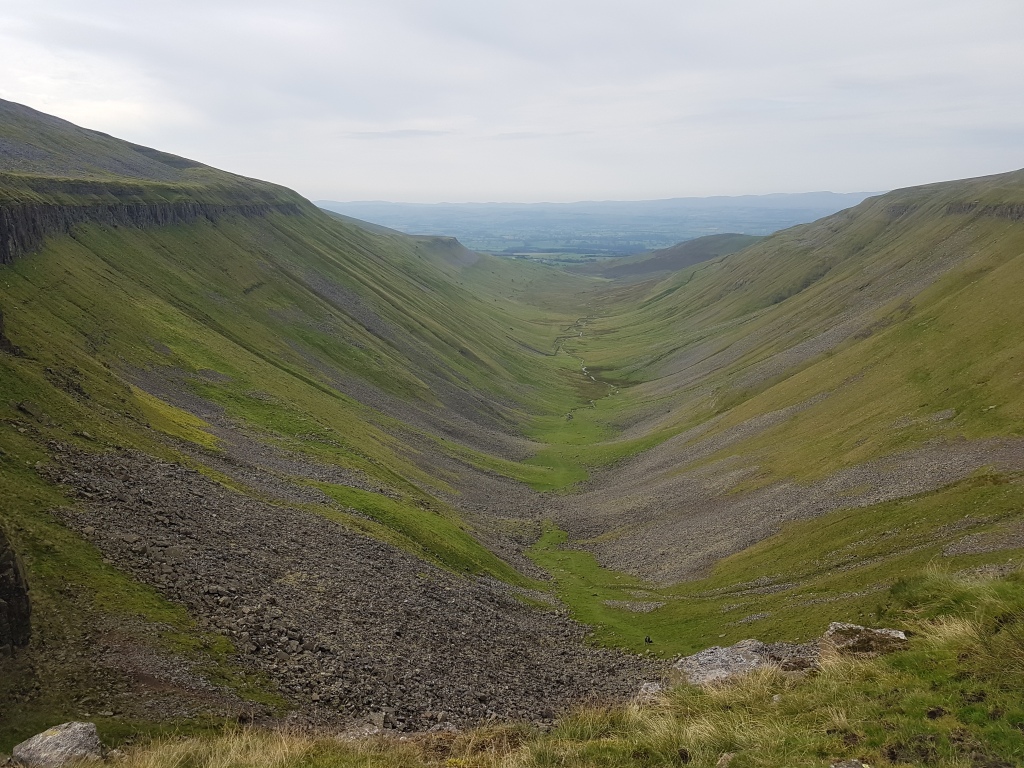
I climbed as dusk was falling, and High Cup Nick appeared (or didn’t appear) to be shrouded in fog and dark which was a shame. The fog was particularly wet and claggy, it almost felt like I was in the clouds rather than just a bit of mist. Odd. I knew what the view should look like from my recce however, and pictured that as I followed the route round the edge of the valley. I knew that the edge of the path I was following was about 6 foot from a very steep drop on my left, so I made bloody sure I didn’t stumble and take a dive!
The long slow descent seemed to take a while, but I eventually hit a road that would lead me in to Dufton. I was met by Bill, a runner with Borrowdale runners who lived locally and was meeting the Spine racers descending. It was great to chat with someone who loved the race like I did, and he told me about the other racers he’d accompanied down the last few miles into Dufton. He also had brought a few snacks to tempt me with (and all the other runners), so offered me a Mars bar, can of Coke and something else I can’t remember. I initially refused on the basis I could get food when I was in Dufton, but he was quite persuasive so I took a can of lovely coke and carried it with me for miles. He was a great guy and really passionate about the race and helping the runners, one of the high points of all the people I met.
Dufton arrived (with Bill leaving me to go to his home) and I stepped into the warmth and light of the Post Box Pantry with a sense of relief. I was halfway on this leg, and had negotiated some horrible bits (like the damn boulder fields) but also I had the toughest part of the leg (and race) to go…I really wasn’t looking forward to the climb out of Dufton.
I asked the two lovely ladies in the cafe for 2 pints of milk, a bowl of soup and a bucket in case I was sick. Although they looked at me a bit strangely, they did what I asked and brought me all three. I’m happy to say the milk and soup stayed down, but the bread roll the y served it with made me retch immediately so went in the bucket. I was just pleased to get the soup inside me!
In fact I ended up having three bowls of soup and another bowl into the flask I was carrying for later. Tasty!
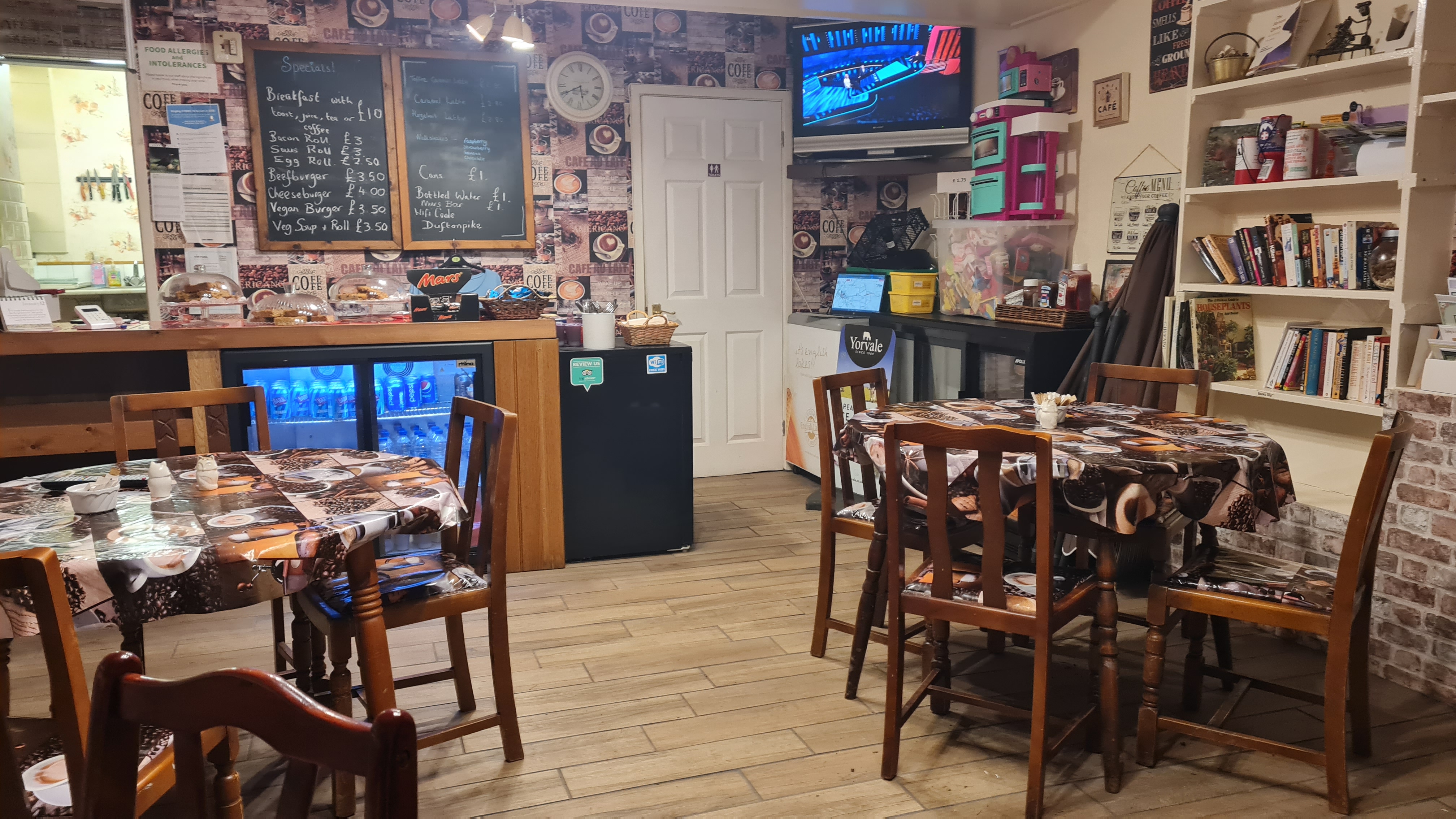

I used the time to sort my kit before tackling Cross Fell, new batteries everywhere and a bit of organisation of my kit so everything was easily accessible and organised. I also got my goggles out and had them ready in case the wind was as strong as I’d been told on the tops. Although I wear normal spectacles, strong wind from the wrong angle can slide in between the glasses and face and funnels across my eyeballs making a particularly unusual pain. Goggles (like ski goggles) were the answer (and part of the mandatory kit)!
As I was finishing up at the cafe, just getting my stuff together, another racer turned up to eat and order about 3 main courses (which I looked at longingly). Mike and I had a chat while he tucked into his food, and we agreed to go over Cross Fell together for the safety of numbers. To be fair, having somebody else to help if you get in trouble, fall into a bog, get blown into the middle of next week seemed like a sensible idea. Mike had already checked into the village hall (a mini-aid station) where he’d grabbed a quick sleep, but said he’d finish his food while I popped into the hall to show my face and show I was still in one piece. Northern Steve, the guy from Tan Hill Inn was there and we exchanged a little banter before I went back into the cold dark night to meet up with Mike and tackle Cross Fell. It was about 7pm when we left Dufton, I’d been on the trail since about 11am.
I’d already explained to Mike that I would be slow up the long climb, and he was very understanding. Almost immediately he started having problems with his GPS unit, and we spent a few minutes rebooting it and trying to get it working properly. Rather sneakily, I would take these halts to have a play with his GPS as opportunities to have a bit of a breather and get my heart rate back down to something sensible.
I cannot stress enough how tough this climb is. From my records it looks like the initial climb is about 2000 feet in 3 miles, and then there are three smaller climbs (Great Dunn Fell, Little Dunn Fell, Cross Fell over the next 3 miles.

I was really struggling, both with lack of energy and my heart rate going at a million miles an hour (making my breathing really difficult as I just couldn’t get enough breath into my lungs). This meant I was having to stop every 45 seconds or so just to catch my breath. Mike was the perfect companion and didn’t put any pressure on me for my slow progress. There are two possible reasons for this….firstly that he was as struggling as much as me, but was following my lead and gratefully stopping when I needed to. The second was that he was relying on me for the navigation over Cross Fell, so was happy to fall in behind me and follow my lead. This made him easily the most trusting person in the world at that stage, and to his credit he never complained or asked if we were going the wrong way. Whatever the reason, he would doggedly stick by me, ready to pull me out of a waist-deep bog when I took a wrong turn, but without pressurising me to find the route when I would pause to double check where we were going. A good guy!
We finally reached the end of the first major climb, and the wind really started to bite. The fog/cloud was absolutely dense and we both paused to put on goggles and tighten up our coats against the wind that was tugging at anything loose. My goggles misted up straightaway and came off immediately, but Mike kept his on throughout.
The route was not easy to follow as we made progress though the dense fog, and on occasion I was having to stop and shine a torch around to try to see tracks of any runners ahead of us. Unfortunately there generally was no sign of anyone passing before us. We had to climb through a few snowdrifts which strangely had no other footprints in, so either we were lost or no-one else had followed the route very closely (I think it was the first reason).
Although I’d recced this section (in daylight) and I knew we had three peaks to get to before descending, I got quite disoriented as we went up and down, and in fact when we finally got to the trig point at the top of Cross Fell I wasn’t sure if it was Cross Fell at all or some other peak that I’d forgotten about. None of the plaques on the trig point actually said “Cross Fell” so without knowing it, we began the descent to Gregs Hut, having survived getting to the top of Britain.
I should probably explain a little about Gregs Hut, if you’ve no idea what I’m talking about. Gregs Hut is a mountain bothy that is an absolute icon of the Spine Race, as it signifies the successful crossing of Cross Fell, and the legend that is John Bamber cooking noodles (with chilli) over a basic stove. There’s no electricity or running water, but strong stone walls and some iconic photos every year, especially when there is snow on the fells. To get to Gregs Hut is a landmark and something to look forward to.

As we descended, the route got really waterlogged, and we were bouncing through thick grass covered in water, so moving quickly seemed to be required to prevent sinking too much into the mush. At one memorable stage I remember having to have a quick sit down (in a dry patch) and shining the torch around to try to work out where the route went. As always, with a bit of rest and clarity the route showed itself quite easily.
I knew the route would turn into a well-established track as we descended, and at some point we turned corner and saw flashing lights that had been erected outside Gregs Hut. I’m not a particularly emotional person, but having known each other for a just a few hours, Mike and I hugged each other with joy as we realised we’d put Cross Fell behind us.
I’m not sure what I expected as we got to Gregs Hut, but was a little underwhelmed with the lack of noisy marching bands celebrating my arrival, or even anyone to say hello. To be fair it was about 2am and the occupants were dealing with some racers that had got there before us. As soon as we got inside though, the welcome was great and the racers ahead of us made their way out into the night and we went in to be greeted by the unique John Bamber, a medic Mary, and another chap that I didn’t get the name of.
It was wonderful to actually be at Gregs Hut, taking part in the Spine Race, something I’d only read about but aspired to for years. I was slightly awe-struck, and absolutely chuffed to bits to have made it that far. John Bamber was making his famous noodles in mess tins, and we chatted about the length of time they had been at the hut, sleeping on the floor with no running water or electricity.
I was excited to be there, but unfortunately not excited enough to fool my stomach into getting some solid food into it, so my noodles remained un-eaten, which I was genuinely gutted about…imagine going for a long-awaited meal at some fancy Marco Pierre White restaurant and then not being able to eat anything. I was gutted.
I was able to take a particularly bad picture for the occasion though!

As we finished up, Mike said he was going to try for 15 minutes sleep in the next room before we headed down the long descent to Alston, so I lent him my thick mittens (he’d been complaining of feeling cold) and he settled down to snore for a bit. Strangely, I wasn’t sleepy despite it being the early hours of the morning (perhaps the excitement of the occasion!)
I woke him after 15 minutes, and we got our packs back on for the long Coffin Road to Garlinge. Mike stated getting some pain in his shins and was a bit slower than me descending, but we made it eventually to a nice bench in Garlinge. I shared my can of Coke with him, that I’d got from Bill as I descended into Dufton. I’d cleverly carried it from Dufton all over the climb to Cross Fell, planning to have it as a celebration at Gregs Hut. With a bit of coke inside us, the pace picked up a little as we followed a river to the next checkpoint Alston.
Alston checkpoint reached approx. Thu 5am, 183 miles done in 93 hours. Checkpoint left at approx. 1.00pm
It seemed to take ages to get there, but thanks goodness it finally arrived. It was 5am on Thursday at this stage, and the last 40 miles (and 2000 metres of climbing) had taken 27 hours. I‘d been on the move for 93 hours, with about 9 hours sleep, and had only eaten decent solid food about 4 times in the last 3 days. There was no question of sorting kit, I had a lovely shower and went to sleep in the highest bunk that has ever been built. My intention had been to stay at the checkpoint for hours, as long as it took to get me caught up on my sleep and recovered mentally to tackle the next leg…if necessary I’d stay for over 12 hours. Unfortunately I was told I was only allowed 8 hours in the checkpoints, and stupidly I’d not realised this before the race.
When I woke up I felt strangely good. I had the section over Cross Fell behind me, which I’d been really concerned about (rightly!) and in fact I only had about 80 hilly miles to go with a decent amount of time to complete it. I was feeling stiff and sore, my feet really REALLY didn’t look very good but as I lay in the bunk I felt a lovely, unusual feeling, that I hadn’t felt for days.
I felt hungry.
As I came downstairs to get my kit sorted, I was aware my feet were pretty trashed, and that I needed to get them taped up and sorted asap. If I could get some food inside me while the medics were taping me up then all the better. So instead of going straight to my drop-bag and sorting kit, I headed for the medics corner, being intercepted on the way by a lovely volunteer who asked what I wanted to eat…did I want lasagne? Oh yes I said, in fact, could I have two as I would have some time sitting down while the medics sorted me out?
I should explain that the lasagne at Alston is something of an institution (with its own Instagram account and everything!) and although I hadn’t really registered it, I was in for a treat!
While the medics ummm’d and aaahhh’d (and more importantly ooooooohhh’d) over my poorly feet, specifically over my little toe that was going a very dodgy colour (and becoming a bit of a star in the medics WhatsApp group where they were sharing pictures of the worst afflictions), I was eating my way through a couple of (admittedly) small portions of lasagne. As soon as I’d finished them, the lovely volunteer came back to collect the plates, and I asked for another. This carried on for a while…the medics doing their stuff and me sitting in a comfy chair eating lasagne. It was a very pleasant place to be for a while, far from the bog and shite of the Pennine Way and allowed me to forget what I was there for.
Feet sorted, I moved to my kit bag and got myself organised. I was time for new waterproof socks and lovely things like that, making me feel like a new man!
And all the time I was eating more lasagne, asking for another plate every time the old one was taken away. It was filling a stomach that had refused solid food for pretty much three days outside the checkpoints, and I’d burnt a gazillion calories in the meantime.
It was with a little surprise then, when I’d asked for my latest lasagne that the volunteer asked if I’d really had 7 portions of it. I said I didn’t know, I wasn’t counting, but that it was lovely lasagne. A couple of minutes later I was accosted and photographed by a couple of medal-wielding volunteers that wanted to crown me the “top lasagne eater at Alston Checkpoint”, having eaten 7 portions. I’m embarrassed to say I felt a little emotional, it was so unexpected and lovely of them.


It was a proper distraction (but not enough of a distraction to not eat the latest lasagne they brought me) and I was a little lost for a while, but then I was told I was nearing my 8 hours’ time-limit in the checkpoint, and was hurried to get my shoes on and get back on the trail. I was absolutely fine with that, as this was without a doubt the best checkpoint in existence, and I didn’t want to break the rules, and got my last bits of kit and shoes on.
Unexpectedly, I was then ambushed by a load of volunteers outside, to celebrate my greedy-guts reputation for eating the most lasagne of all the runners that had been through the checkpoint. Just time for a classic picture (which I shall treasure) and it was back on the race!
The next stage was Alston to Bellingham, a chunky 40 miles with 1674m ascent. This leg would take me along a long section of Hadrian’s Wall, then a long diversion leading to Horneystead Farm, a Pennine Way institution (but more of that later).
I had a full stomach, a healthy lead over the cut-offs meaning that I was going to get a good sleep at Bellingham checkpoint, and the knowledge that the final leg was only 28 miles rather than the usual 40 due to storm-damaged forests that we could not go through. I was not looking forward to this leg, but knew that it was moving me towards the end. The end!
I had recced this section, but strangely I could not remember much about the first part of trail to where it met Hadrian’s Wall. As I travelled up this part, called Isaac’s Tea Trail, I remembered why…it is a rubbish boggy trail with absolutely no redeeming features, lots of rolling hills, lots of slippery climbs and mud. What a crap-hole.
I played leapfrog with another racer a few times, a guy called Rob that I would spend time with later. At one road crossing, there was a couple of plastic boxes full of snacks and water, labelled “For Spine Racers”. It was a pleasant surprise and the Haribo sweets I took were a lovely change to my boiled sweets I’d been living on.
I left Alston at about 1.00pm, and it was dark 3.5 hours later. I got to Greenhead when it was dark and a couple of volunteers were manning the public toilets (yes, really) and helping the runners with hot water. I had a couple of cup-a-soups, which went down really well, and had 10 minutes sleep on a convenient bench. I also refilled my flask with more soup as I did not realise until I asked that Horneystead Farm was 20 miles away, which is a long time to go without access to water…potentially 8-9 hours of hiking with no breaks.
As I set off, for some reason I became very thirsty and although I had a decent amount of water with me, when I got to the next set of public toilets (there was about three sets all within a few miles of each other) I spied an outside tap, and quickly drank about half of my water to try to stop being so thirsty. Unfortunately I then tried the tap, which had obviously been switched off when all the toilets were locked up. Oh dear. I had about 250ml of water to last me the next 17ish miles which wasn’t really going to work. I briefly though about heading back to the last set of public toilets, but quickly discounted that. I had a full stomach of water, which was going to last me a while, and no-one had ever died of thirst while on the Pennine Way…there was always water around, it just wasn’t very clean sometimes.
So I moved on, and began the section of Hadrian’s Wall. It’s a beautiful section, with a lot of very sharp climbs and then descents following the route of the wall. On my recce, done in daylight, I’d been able to see all the views (like at High Cup Nick) and I had to imagine what I was missing as it was pitch black.
At about midnight I reached Steel Rig where we were diverted onto a road, and a volunteer showed me the route on my map that I needed to follow to avoid a few sections of trees that had been weakened by a recent storm. I was a little nervous at leaving the GPS route and following my map, but I seemed to cope with it (and to be fair I could see the actual Hadrian’s Wall on my far left at all times so it was not too difficult.)
After this part of the wall I started to find a few farmhouses and outbuildings, and I carefully shone my torch all around the outsides looking for an outside tap to fill up my water with. I’d been perhaps 4 hours without much water, and while it was just uncomfortable so far, I was keen to find a water-source before having to resort to bog-water.
Finally I found a small cottage alongside the trail, and tip-toed into their garden to access their tap. I’m not exaggerating when I say I drank 1.5 litres of water before filling all my bottles and getting on my way. I hope no-one was looking out of the window while I was doing it as I must have looked a state!
After Hadrian’s Wall was a 6ish mile diversion, firstly following the wall and then going across some fields before turning north to get to Horneystead Farm and a much-needed rest. It was getting to be very late, and I was starting to fall asleep on my feet. At about midnight I took a couple of pro-plus as I was losing track of the route, which perked me up for an hour, but did not last.
The diversion turned into the section of field, and I couldn’t understand why I was struggling to find the path so much. Until I realised the diversion was just a straight line across miles of fields, and it was going to be a bit of pot luck to find stiles over walls and the best place for river crossings. It may have been obvious in the daylight, but it felt very complicated while half-asleep at night.
I think these early hours of the morning, 2 to 6am were probably my lowest point of the whole race (with the Cam Road a close second!) as it was just endless, boring and pitch black. My only possibility of getting through this section was just to keep going, even though all I wanted to do was stop and never move again. I would tell myself that all I had to do was keep putting one foot in front of the other, that I had no other purpose in being there than to keep moving. I had not spoken to my wife for the best part of the week, simply so that I could just keep walking. I had trained hard for the best part of 6 months so that I could keep walking. My life just consisted of keeping going, keeping moving. It was as simple as that. My stubbornness was a living, breathing thing!
At about 4.30am I gave up trying to stay awake, and had a much needed 30 minutes sleep at the trail side. I was lucky top find a sheltered hollow for this, and although I woke up cold and disoriented I made myself get moving and quickly warmed up. Shortly after waking up I saw two very bright lights heading towards me extremely quickly, and was gobsmacked to find I was adjacent to a road that had a lorry moving along it. It was a bizarre sight after so many hours of darkness, and that I was not aware of the road at all.
The last few miles into Horneystead Farm were horrible, tracks that had been churned up by tractors and machinery that were being used to deal with the local weakened forests. I properly lost my sense of humour here, even though it was getting light, and spent a good couple of hours composing emails to people I didn’t like telling them why I didn’t like them. I’ve never done this before, and hope to never need such an approach again, but it did the trick giving me a vent for a bit of aggression to keep moving for these last few miles.
Horneystead Farm is on the Pennine Way route, where a farmer & his wife have created an outbuilding with some comfy sofas, kettle, food, heating and basically everything a tired hiker could want. They keep this open 24/7 for all Pennine Way hikers, and I’d passed the gate in September 2021 on my recce. At the time I’d spoken to the wife, who had invited me in but I’d said that I’d only come in during the race in January. I had been looking forward to it, but I was genuinely a little worried about getting to Horneystead Farm and being in such a foul mood that I would be rude to the lovely people that run it.
Luckily, my mood lifted the minute I got into the warm environment, sank into a lovely sofa and was offered some hot soup by the wife, who chatted away for a few minutes, telling me that she (and husband) had walked the PCT in 2006 and how much she enjoyed seeing everyone coming in. I struggle to put into words how welcoming that place was, and how fabulous it was to just be able to sink into a sofa after the night I’d had. Horneystead Farm rightly has a reputation as an oasis of comfort in a sea of bog and mud, and the couple that provide it are the absolute salt of the earth, taking enjoyment from the gratitude of their many visitors.
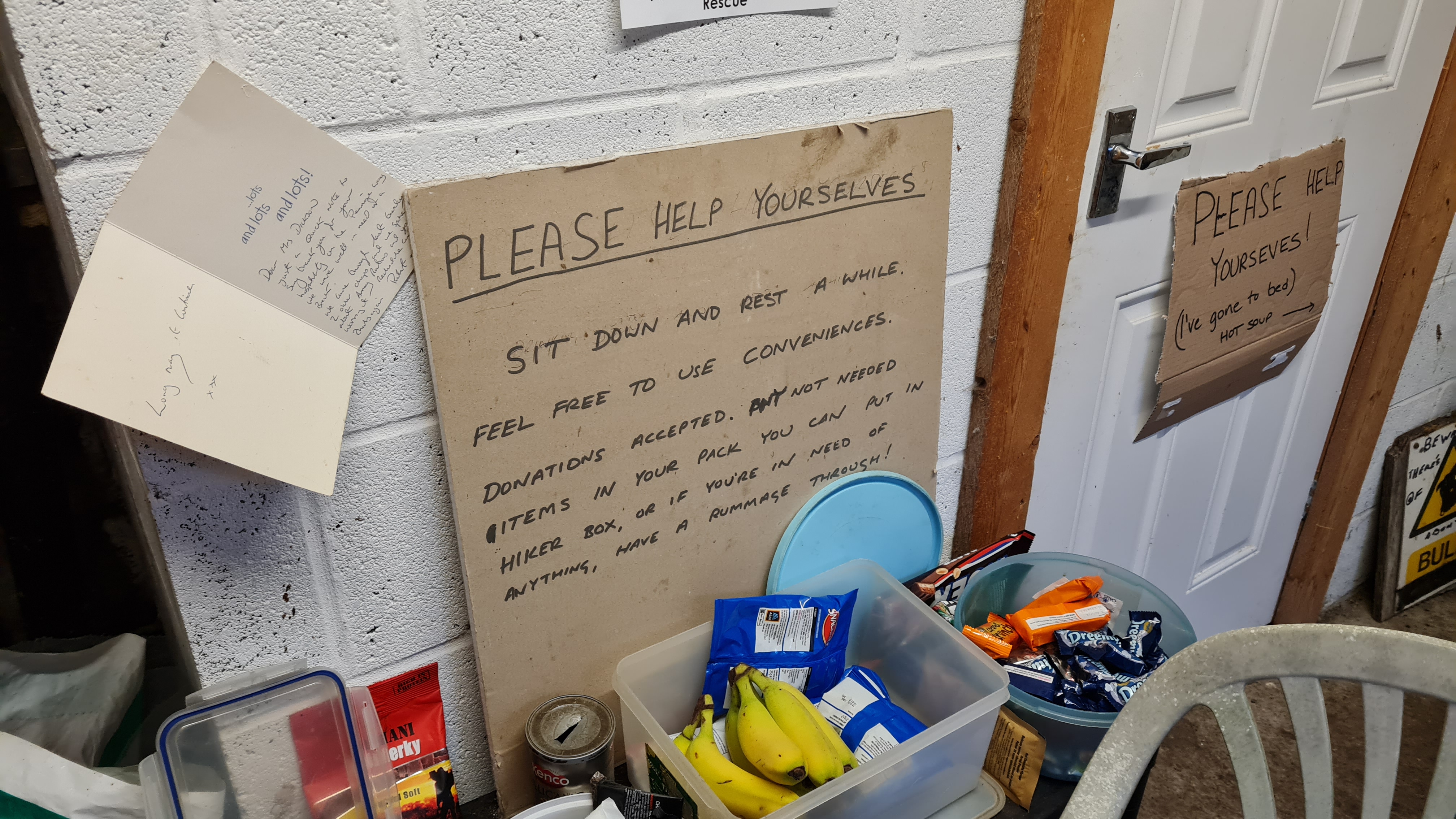
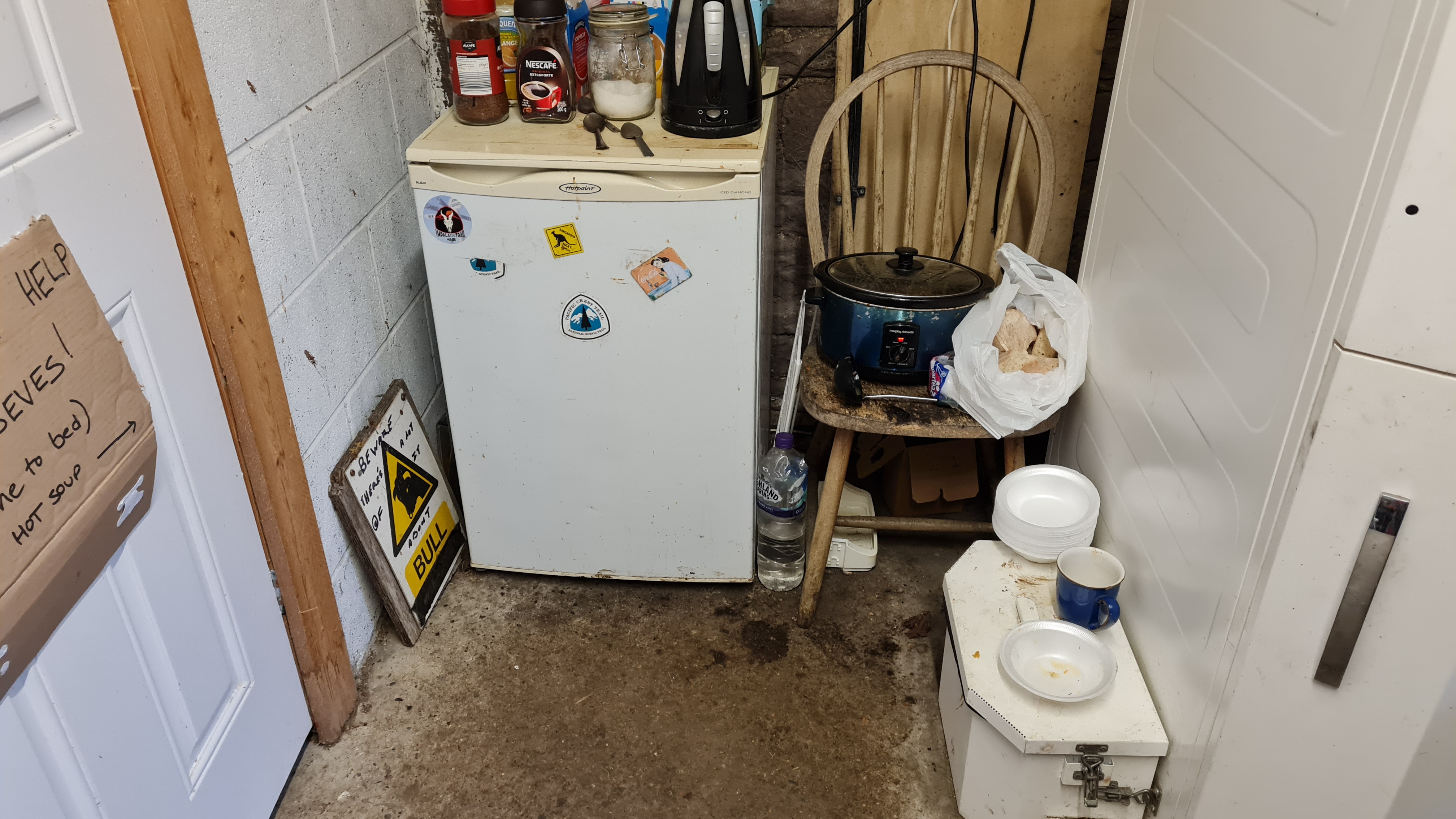
I spied Mike (that I’d gone over Cross Fell with) asleep in another sofa, buried under a load of quilts and not snoring for a change. He gradually woke up as I was chatting with the wife, and we left together a half-hour later. I was keen to get the next 5 miles to Bellingham checkpoint out of the way as soon as possible and set off at a cracking pace. The final descent into Bellingham was particularly muddy, having had a load of racers over it already, but I didn’t care as all I wanted to do was get there and get some sleep.
Bellingham checkpoint reached approx. Fri 11am, 228 miles done in 123 hours. Checkpoint left at approx. 6.30pm
An organised checkpoint had me removing all my muddy boots and waterproof trousers in a gazebo outside, and then getting inside where I was greeted by volunteer Debs White, who I’d volunteered with in 2020. It was great to see a friendly face, but all I wanted to do was sleep so I made my excuses, had a shower and went into an adjacent hall and slept on a surprisingly hard floor with my sleep mat. As usual, with a few snoring rhinos in the corner, I was asleep in seconds and 5 hours later gradually surfaced feeling much happier.
I’d arrived at about 11am, so when I came out of the sleep room (with the extremely hard floor) it was dark already. But I was awake and alert and looking forward to the last leg and getting this damn thing done. My feet had woken up and were showing few new blisters to go with my old ones, so it was first stop at the medics, while eating food and drinking coffee. The food was good, but it didn’t go down as easily as at previous Alston and I struggled a bit to get the calories in…I still wasn’t managing much solid food on the trail and I knew this was (potentially) my last food before the finish. Mary the medic was very gentle, but I still jumped every time she poked and prodded my feet while taping. She carefully drew a line on the angry little toe, to show how far the infection and rot had moved up it, before putting it on the medic WhatsApp group for review at the finish, to understand if the infection was moving (so she told me). A guy named Rob and I were sitting opposite each other while having our feet sorted and chatted away about our experiences so far, while eating and wincing with foot-taping-pain. Good ouchy fun.



After surgery, I sorted my kit, reminding myself that it was probably the last time I would be doing it, and to absolutely not forget anything.
I’d been extremely fortunate so far that I hadn’t set off from a checkpoint without forgetting anything important, so I wanted to keep the positive record going. To be fair, if I did forget something my nature would be to just work out a fix, but it is the mental beating up I would give myself that is the bigger issue. Rather like making a navigation error, where the error is quite easily fixed, but the frustration at going the wrong way is far more significant.
I had a brief chat with Lindley Chambers about the diversion we were taking and the likely terrain we would find, which did not sound too disastrous. I also tried to find out who was likely to be meeting us at Hut 1, a mountain refuge hut about 9 miles into this leg, which would be a welcome place to stop and rest before the final push of 19 miles to the end. I had promised myself that I would not have another night spent awake and slogging through the sleep monsters, so a sleep at the hut would break up this leg nicely, while wasting some of the darkness and making me finish (hopefully) in daylight.
I touched base with Rob to see if he wanted to set off together, which he did, so we agreed on another 20 minutes of getting sorted and then we’d make a move. The route was shortened to 28 miles, rather than the usual 40 for his leg, and even better we were getting driven in a car for the 12 miles…imagine moving faster than 3mph for a change!! It was going be a real treat.
I realised just how tired and jaded I was as I said my goodbyes to Debs, asking her to do up the zip on my purple drop-bag….not only was my drop-bag not purple, but I couldn’t get the damn thing to zip up properly. I think I was probably a lot more knackered than I was letting myself believe, but by keeping moving and focused I could stay on target.
I sat in the back of the car, and was asleep in about 0.5 seconds. Getting out at the other end was slightly less fun, but my feet soon got the message that we weren’t stopping anytime soon and quietened down. We had left the checkpoint at about 6.30pm I think, and we had a long climb to get up to the heights of the Cheviots where we would find Hut 1.
On the way Rob and I chatted, and he admitted he felt a little out of his depth on the Spine (didn’t we all!) as his history was doing marathons very quickly (2hr50), doing 1000 miles self-supported across Eastern Europe (Forest Gump style) and setting up his own business with some friends. He was a great example of the unusual and interesting people you meet doing these crazy races!
After what felt like a long time (but it was probably only 5 or 6 hours), we got to hut 1, and were met outside by a mountain rescue guy that welcomed us and asked us to be quiet as there was someone sleeping inside. The minute I stepped inside the small hut (probably 3m by 1m) and hearing the snoring it was clear that Mike had got ahead of me and was crashed out in the hut. I still don’t know how he got ahead of me, as he wasn’t at Bellingham when I went to sleep, and he wasn’t there when I woke up…but somehow he got in there and out in the 5 hours I slept.
Anyway, I’d caught up the snoring man, and he was fast asleep again. Rob and I had a bit of a chat with the MR guys, while we had some of their hot water for soup (for me) and a dehydrated meal (for Rob). With a stomach full of soup, I just leaned over to my right on the bench I was sitting on, and was asleep in seconds, in perhaps the most uncomfortable position I could imagine. I would awake periodically as I got colder and more uncomfortable, or my legs twitched, or my feet moved, but always managed to get back to sleep. As I was getting colder, I put on some thick mittens on my hands, but there wasn’t much I could do to keep the rest of me warm as I was already wearing most of my clothes.
I woke up feeling really shivery, about 3 hours later, to realise that Rob and Mike had left, and I was being watched silently (yes, really) by one mountain rescue guy and his dog, while the others had a sleep in their tents outside.
I had a lovely hour chatting with MR guy (apologies, I can’t remember his name, but the Collie dog was Dottie I think), and drinking multiple cup-a-soups and coffee. I think I had 5 soups and 2 coffees by the end, and they gave me just the boost I needed.
At about 4am, when the next racer was just reaching hut 1 and would need my space, I got my stuff together and left. It was the most extraordinarily clear night, without a breath of wind and bitingly cold, and the sight in front of me was fabulous.



I just drank this view in, believing for the first time that I may actually finish the Spine. I had 18 miles to go, and I was exhausted, but I had plenty of time and just needed to keep moving forward over the Cheviots.
I probably need to explain the mind-set I’d occupied up to this point, to demonstrate the massive difference in my head once I left hut 1. I’d been very focused so far on concentrating on what I was doing…this race did not allow you to forget where you were or what you were doing for any length of time. I’d told my wife not to call me until the Wednesday (after starting Sunday) but being as focused as I was, I’d then told her not to call until nearer the end…meaning I hadn’t spoken to her in nearly a week (the longest we had gone without talking in over 25 years). To be fair, we’d exchanged a few texts, to let her know I was ok, but probably less than 10. Even my running friends, who I would normally speak to daily (if not more often), had realised that I was simply totally absorbed by the race, and my usual fairly relaxed demeanour had deserted me for this race.
Leaving hut 1, into the still night, meant that provided I did not break a leg by falling over, I should finish. I took massive pleasure in texting my wife and friends with a picture of the night (even in the middle of the night), and the news that I was expecting to finish. It’s a magical memory.
But I still had miles to go, and after the initial euphoria wore off it was just a long long hard slog. The ground was wet but crisp on the surface as it had frozen overnight, and the hills were relentless. I was back to my method of stopping frequently just to catch my breath, and some of my slowest miles were taking 30-40 minutes (with 40 minutes being my all-time slowest).
It got light slowly, and dawn was a lovely sight, realising I had completed my last night on the trail. My next sleep would be in a proper bed, which was an amazing thought. I passed a couple of photographers on the peaks that would take a lovely shot of the sun rising behind me, and they tried to have a quick chat with me while videoing it. I don’t think I was very capable of stringing two words together at this point, so I hope those videos never materialise.

A sharp descent down to hut 2 (another refuge hut, about 8 miles from the finish line) was taken unbelievably carefully so that I did not DNF with a broken leg or cracked skull, and I was a little surprised to see quite a crowd at hut 2. There were more mountain rescue guys making sure the racers were ok, but also a load of runners that had come out to see the racers. I was in no mood for stopping here, and just carried on past, hurrying to the finish.
A few other locals were on the trail, and it was great to see ‘normal’ people. I started to get more and more emotional as I neared the end…even with 3 hours to go, just knowing I was going to finish had me in pieces both mentally and emotionally. I had invested so much time and effort into my preparation for this race, and had placed it high on a pedestal for so long, that just the thought of getting to the finish was a mind-blowing thought.
I struggled up (and then down) the last hill, called the Schill, which was a lot steeper than I remember, and then I was heading downwards to Kirk Yetholm, the Border Pub (which has the famous wall that signifies the end of the Pennine Way), and civilisation…including beer, Doritos and a bed.
I passed through the farmyard that is the last bit of trail, and then onto tarmac road which was the last 2 miles to the finish. A couple of cars went past, hooting at me to celebrate the nearing the finish line. And then the village came into view. And then I was turning the last corner, to be able to see the finish line in the distance with a crowd of people waiting for me….little old me…who had somehow finished the spine race.
I’ll admit I was in no hurry to get to the wall, but savoured the feeling as I went under the finish gantry. I was in floods of tears (very unmanly of me!) and could not see anything but that damn wall to touch. No apologies, one of the most memorable race finishes I’ve ever had (and I’ve had a few).

Finish time – Sat 12.23pm, 148 hours 23 minutes. 57th of 72 finishers of 121 starters (40% dnf rate)
I had a medal put over my neck, had time to answer a couple of questions from the crowd, which I have no recollection of at all, and then was shown indoors for a sit down. I was a little overwhelmed by pretty much everything at this stage, and just sat for a few minutes gathering my head. I saw Mike in the room and we had a few words about the finishing experience.



My superstar friend Steve had driven up from Kent that morning, to be there for the finish, and I just about registered him in the crowd as I finished. I popped outside to say hello and thanks for coming – it was great to see a friendly face, almost from a previous life. Steve, on the ball as always, let me get back inside to sit and get as much of my muddy kit off as possible, while drinking pints of milk. Absolutely lovely.
I soaked my feet in a tub of hot water, and managed to peel off most of the tape covering my feet which was extremely painful but would allow them to dry out as much as possible. I would give them a few hours and then comeback for the medics to take a look.
I had finished at about 12.30pm on Saturday afternoon, a total of 148 hours after setting off from Edale 268 miles earlier. 6 days and 4.5 hours. I had slept for about 20 hours at the most over that time, which I think was quite a lot compared to some others, but was the absolute the minimum I could cope with.
Steve and I walked (well, he walked, I hobbled) to the local B&B we had booked for that night, and I had the best shower of my life. Then I had the best beer and Doritos of my life while I texted people telling them I had finished. I was a Spine finisher. Unbelievable. Then I passed out/fell asleep for a few hours.
Then, feeling much more human, I got my feet checked out by the medics for the last time (“get to a doctor when you get home, they’ll probably give you antibiotics for the infection etc.”) and hit the pub with Steve for food, food and more food, and beer. God, what a great feeling.
And that’s it! The end of years of aspiring to finish (probably) the hardest ultra in the UK.
The end of (I think) my racing career – I cannot see any real need to do anymore massive races. If you ask a climber which mountain they are likely to climb after summiting Everest, I imagine they will look at you a bit strangely. I’m feeling the same way, what race could I possibly want to do that would set me that same sort of challenge as the Spine? I absolutely need to fix my hamstring to be able to run, and I need to run….but I do not feel the need to go to the extremes of the last few years (Arc of Attrition, Thames Ring 250, Spine Challenger, Monarchs Way etc.)
I think I’m retired! Incidentally, literally everyone that knows me has said I will reconsider this statement, but ‘m not so sure. Time will tell.
And if I have retired, what a race to bow out on!
So, a couple of thanks, as usual…
Firstly to the awesome organisers of the race, to the brilliant volunteers at every checkpoint, to the mountain rescue guys (especially at hut 1) that were ever-present to make sure we were safe. Thanks to the lasagne at Alston that gave me some much needed energy and fabulous memories of winning the most unexpected medal ever.
Thanks to John, Mark, Sharon, Derek and Pam…for keeping me sane even though I hardly spoke to you. Just knowing you were out thinking of me and dot-watching made all the difference.
Thanks to my wife, the long-suffering (gorgeous, wonderful, clever, beautiful, wise & generally lovely) Claire, who has put up with this obsession (dare I use that word?) for years and was really really clear with me that she did not want me to do this race. But then supported me fully when she saw I was going to do it anyway. Love you. Thanks also to my kids, who were entirely un-phased by their dad disappearing for hours at a time and almost killing himself for the previous few months, and just carried on as normal.
Thanks to my poor feet, who were just as smashed up as during the Monarchs Way, even though this race took half the time. No more, I promise!
And thanks to all the organisers of my races over the years, from the very first 100 miler I did organised by Mike Inkster in 2011 here in Kent, to Lindley Chambers who I seem to have done most of the really ridiculous races with.
This has, I think, been my longest race report ever. And you’ve made it to the end…so thanks to you, reader, for persevering to the end. If you aspire, like I did, to finish the Spine…then hopefully you’ve got your entry in and have a read HERE for my kit choices and training thoughts.
If you are just reading because you like hearing about my suffering….you’re welcome!
And that’s it. THE END


————————————–
————————————–
————————————–
————————————–
And now for all the pictures that didn’t make the cut….
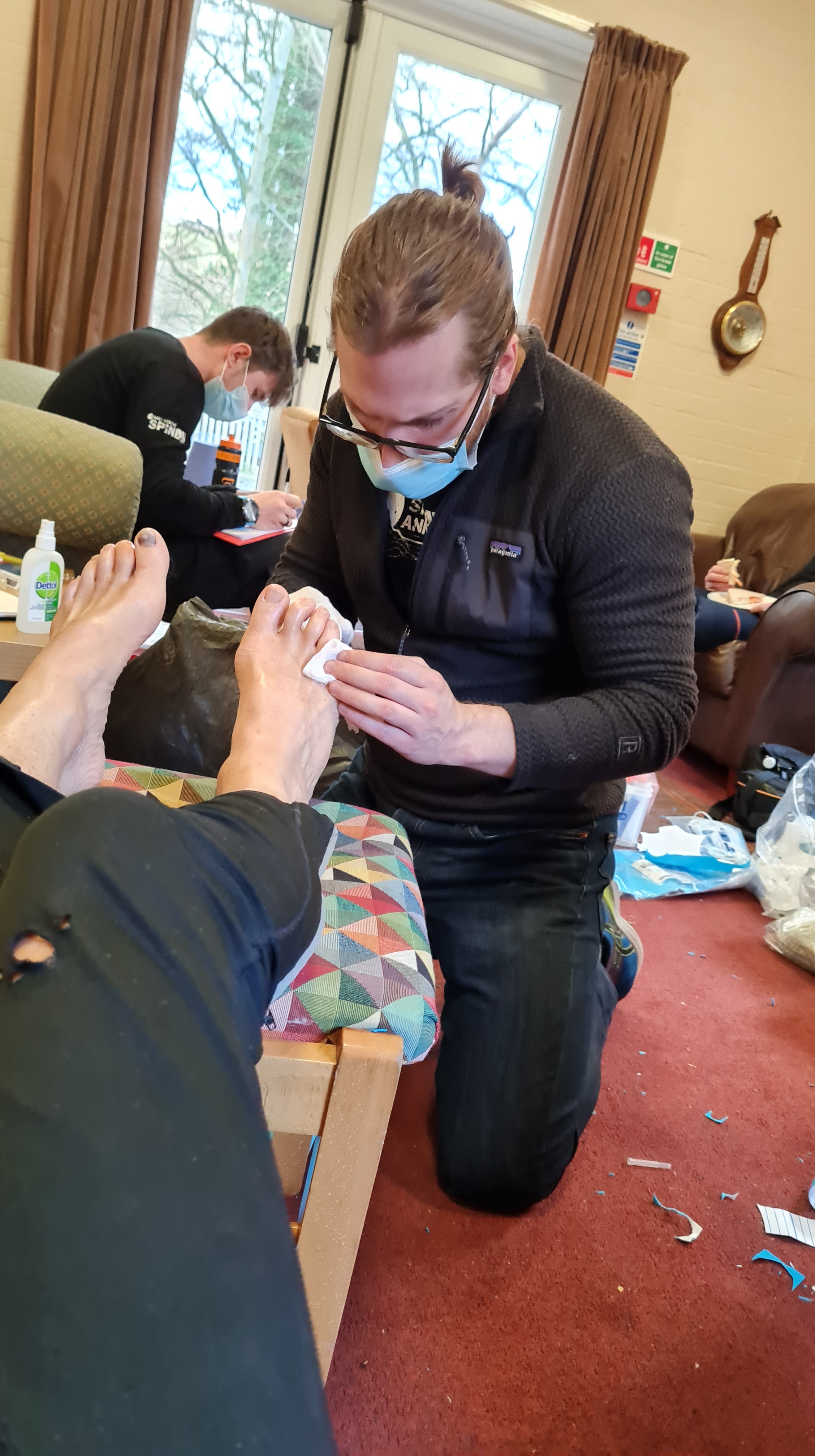





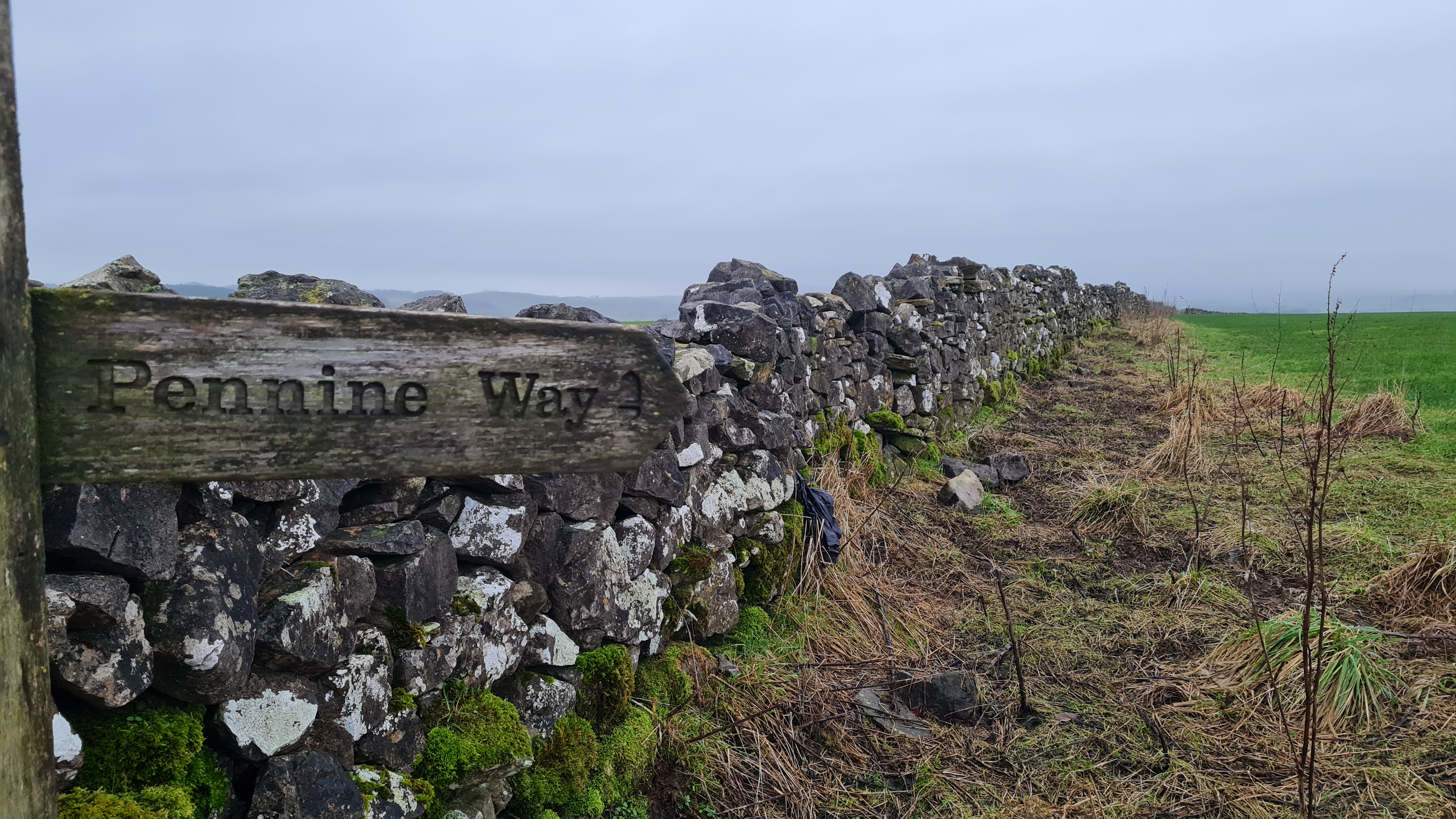



Incidentally, despite all this talk about retiring…my head has been turned by a rather interesting race called the Montane Yukon Arctic Ultra. Hmmmmm….


